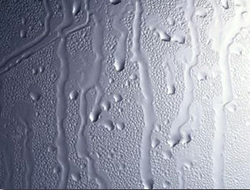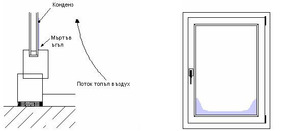How the condensation on windows and window frames is forming?

Author: Institute for window technology, Rosenheim, Germany
In principle, condensation may appear on the surface from the room side of the glass, resp. window frames.
Then he spoke about sweating or blurred window. This phenomenon, however, should not be confused with the appearance of condensation inside the glass.
The reasons for the formation of condensation on the surface of building elements (eg, windows, window frames)
from space are explained below.
In residential areas are continuously released water vapor. Can take the following amounts:
- Breath of the person's daily intake of 1 to 2 liters;
- Cooking pay day to 2 liters for a family of four;
- Bathing, washing, watering the flowers, etc.. Such individual to 3 liters a day in a family of four.
In principle, condensation may appear on the surface from the room side of the glass, resp. window frames.
Then he spoke about sweating or blurred window. This phenomenon, however, should not be confused with the appearance of condensation inside the glass.
The reasons for the formation of condensation on the surface of building elements (eg, windows, window frames)
from space are explained below.
In residential areas are continuously released water vapor. Can take the following amounts:
- Breath of the person's daily intake of 1 to 2 liters;
- Cooking pay day to 2 liters for a family of four;
- Bathing, washing, watering the flowers, etc.. Such individual to 3 liters a day in a family of four.
Average amount emitted steam

In residential areas are continuously released water vapor. Can take the following amounts:
-Breath of a person's daily intake of 1 to 2 liters;- Cooking pay day to 2 liters for a family of four;
- Bathing, washing, watering the flowers, etc.. Such individual to 3 liters a day in a family of four.
These amounts of moisture contained in the air as an invisible water vapor. For example, 1 cubic meter of air at 0 ° C can contain a maximum of 5 g (= 5 cm3) of water vapor. If the room temperature is higher, the air can hold more water. Thus, the water content rises at 20 ° C to 17 g, and at 30 ° C more than 30 g per m3.
However, if the air contains the maximum amount of water vapor, it does not accept any more moisture in the form of water vapor. In this case, refers to saturated air. When we have the so-called saturated air. "Relative humidity" of 100%, ie in 1 m3 of air containing the "maximum" amount of water vapor. 50% humidity in 1 m3 of air contains only half of the possible maximum.
For example, a room with a total area of 15 m2 and a height of 2,5 m. A volume of 38 circular m3. If the air has a temperature of 23 ° C, then in this space (at 100% air humidity ) rests almost 1 liter of water in the form of visible steam . When such a " heavy water " air comes into contact , such as during the winter, with the cold glass of the window , then the water vapor " condenses " and is deposited as visible water on the glass. Therefore, dew condensation occurs when the humidity inside the room is relatively high and the temperature of the inner surface of the glass is low.
-Breath of a person's daily intake of 1 to 2 liters;- Cooking pay day to 2 liters for a family of four;
- Bathing, washing, watering the flowers, etc.. Such individual to 3 liters a day in a family of four.
These amounts of moisture contained in the air as an invisible water vapor. For example, 1 cubic meter of air at 0 ° C can contain a maximum of 5 g (= 5 cm3) of water vapor. If the room temperature is higher, the air can hold more water. Thus, the water content rises at 20 ° C to 17 g, and at 30 ° C more than 30 g per m3.
However, if the air contains the maximum amount of water vapor, it does not accept any more moisture in the form of water vapor. In this case, refers to saturated air. When we have the so-called saturated air. "Relative humidity" of 100%, ie in 1 m3 of air containing the "maximum" amount of water vapor. 50% humidity in 1 m3 of air contains only half of the possible maximum.
For example, a room with a total area of 15 m2 and a height of 2,5 m. A volume of 38 circular m3. If the air has a temperature of 23 ° C, then in this space (at 100% air humidity ) rests almost 1 liter of water in the form of visible steam . When such a " heavy water " air comes into contact , such as during the winter, with the cold glass of the window , then the water vapor " condenses " and is deposited as visible water on the glass. Therefore, dew condensation occurs when the humidity inside the room is relatively high and the temperature of the inner surface of the glass is low.
Condensation starts from the end of the glass

Condensation starts at the end of the glass, determined by the unfavorable terms of thermal engineering connection between two panes of glass . Furthermore, wide sills ( sills ) and the frame of the wing may hinder air flow , so that the moisture in the bottom of the glass may appear earlier than at its middle . Condensation can occur with glass windows especially in unheated rooms (eg bedrooms) . The reason is that such space gradually cool overnight , and the air saturated with water vapor from the breath at a relatively low temperature.
Reducing the formation of condensation can be achieved by changing the movement of the warm air, resp. by appropriate positioning of radiators. Possibly warm air flow must pass close by the window, so as to achieve higher heat transfer coefficient. In previously installed windows can reduce the risk of condensation through holes in the inner sills. Below is presented the influence of the different embodiments of the windows on the danger of the occurrence of condensation.
Implementation of the window:
- The danger of condensation is increased at a low temperature on the surface of the screen and frame. So-called "dead corners" within the area of the frame reduces the coefficient of heat transfer (convection is very limited), and at the same time leads to a drop in temperature of the surface.
- In the absence of heater situation becomes even worse.
- Reduces the risk of condensation from passing by the window warm air from the radiator. Thus, raising the temperature of the window surface.
- The danger of condensation increases as the depth of embedding window is large and due to lack of convection in desk / wall occurs the so-called "blind spot." This leads to a drop in temperature of the surface.
These explanations show that condensation - even on glass - it depends on the air movement, the location of the heater and ventilation habits of the occupants, but not the design of the window or glazing.
Reducing the formation of condensation can be achieved by changing the movement of the warm air, resp. by appropriate positioning of radiators. Possibly warm air flow must pass close by the window, so as to achieve higher heat transfer coefficient. In previously installed windows can reduce the risk of condensation through holes in the inner sills. Below is presented the influence of the different embodiments of the windows on the danger of the occurrence of condensation.
Implementation of the window:
- The danger of condensation is increased at a low temperature on the surface of the screen and frame. So-called "dead corners" within the area of the frame reduces the coefficient of heat transfer (convection is very limited), and at the same time leads to a drop in temperature of the surface.
- In the absence of heater situation becomes even worse.
- Reduces the risk of condensation from passing by the window warm air from the radiator. Thus, raising the temperature of the window surface.
- The danger of condensation increases as the depth of embedding window is large and due to lack of convection in desk / wall occurs the so-called "blind spot." This leads to a drop in temperature of the surface.
These explanations show that condensation - even on glass - it depends on the air movement, the location of the heater and ventilation habits of the occupants, but not the design of the window or glazing.
How to deal with condensation

Often after replacing the old windows with PVC such appear condensation and moss that customers blame "faulty" new windows and the company that installed and it even came to the wrong conclusion that "only the wooden windows does condensation." The truth is quite different.
Old windows do not seal well , resulting in the formation of an undesirable permanent aeration , wherein the moist air leaving the room , but with it goes , and so valuable heat. After replacing the windows , the room is " sealed " water vapor can not leave it , the humidity rises and condensation occurs on the coldest surfaces - mostly walls and windows. In new construction also gets high humidity due to evaporation of moisture accumulated in the building materials themselves , a process that lasts about a year .
To solve the problem of condensation, in almost all cases be sufficient:
To prevent condensation and mold, remove the factors that cause them: high humidity and cold surfaces.
How to reduce humidity?
How to reduce cold surfaces, which eliminate condensation and improve insulation and comfort, while reducing the cost of heating?
The most effective and easy to implement methods to prevent condensation, unless ventilation, of course, glazing with Low-E glass and thermal ceramic paints. If you add external insulation, you get a complete solution.
Old windows do not seal well , resulting in the formation of an undesirable permanent aeration , wherein the moist air leaving the room , but with it goes , and so valuable heat. After replacing the windows , the room is " sealed " water vapor can not leave it , the humidity rises and condensation occurs on the coldest surfaces - mostly walls and windows. In new construction also gets high humidity due to evaporation of moisture accumulated in the building materials themselves , a process that lasts about a year .
To solve the problem of condensation, in almost all cases be sufficient:
- regular airing
- windows with low-e glass
- external insulation
- glazed with so-called 'warm edge' spacer SWISSPACER
To prevent condensation and mold, remove the factors that cause them: high humidity and cold surfaces.
How to reduce humidity?
- Ventilate at regular spaces for 5 minutes several times a day. This will not only reduce the humidity , but it will refresh . Do not worry about the loss of heat in the room - the heat accumulated in the air is significantly less than that stored in the furniture items and the walls. If ventilate in a wide open window , creating over a short time , the temperature will recover very quickly. Avoid keeping the window slightly ajar for a long time, continuing influx of cold air will cool the walls and furniture , and then the temperature will recover more slowly and by a large expenditure of energy;
- Avoid drying clothes on the premises;
- Did not ventilate wet areas (eg bathrooms) by opening their doors. Instead, use fans in the ventilation shaft.;
- When cooking use the hood to take away the steam and odors out;
- Move the flowers outside the rooms with condensation;
How to reduce cold surfaces, which eliminate condensation and improve insulation and comfort, while reducing the cost of heating?
The most effective and easy to implement methods to prevent condensation, unless ventilation, of course, glazing with Low-E glass and thermal ceramic paints. If you add external insulation, you get a complete solution.

